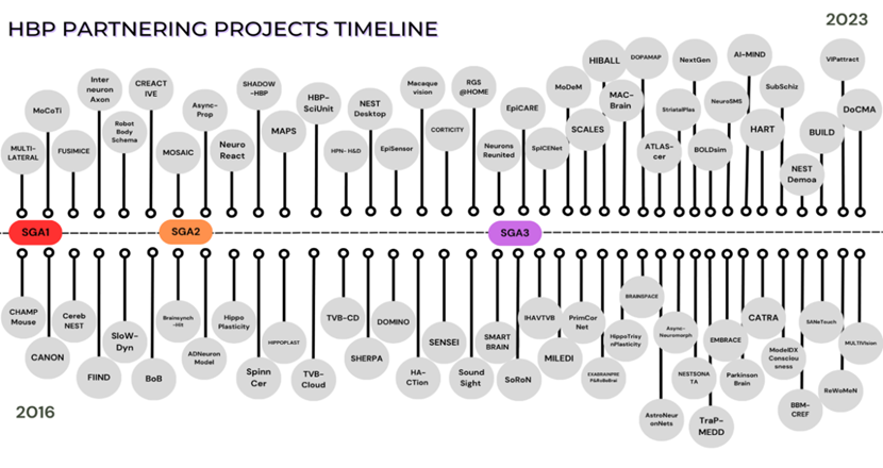Partnering Projects
The partnering mechanism allowed a funded project to add new knowledge, competencies, ideas and resources to the HBP Flagship, and to benefit from the Research Infrastructure and the other capabilities made available by the HBP.

Partnering Projects were important to create synergies between the Human Brain Project and the activities receiving funding at regional, national or transnational level. Openness was key to the ability of the HBP to remain at the cutting edge of scientific, technological and innovation developments.
Partnering Projects allowed the EBRAINS Research Infrastructure (RI) to engage stakeholders with a formal and facilitated management process in which all Project stakeholders voluntarily agree to adopt a cooperative, team-based approach to observe successful project outcomes and contribute to the EBRAINS’ mission: to continue serving the scientific and academic community in further boosting research in brain science, combining neuroscience with modern ICT, and translate that knowledge into medical and technological progress, and concrete implementation output, benefiting patients and society. These formal processes are envisaged to foster longer-term and closer relationships with the stakeholders, which could potentially contribute to the construction and consolidation of the RI.
What was a Partnering Project?
Partnering Projects (PPs) and their partners, who become for many of them Associated Members (AMs) were part of the Flagship. Many contributed to the implementation of the HBP research roadmap by performing research, innovation and networking activities of mutual interest in cooperation with HBP Core Project members. *This included:
- Performing research that added novel capabilities to the RI;
- Performing research that used the RI to address previously intractable issues in neuroscience;
- Developing novel computing and robotics technologies and applications;
- Improving the understanding, diagnosis and treatment of brain disorders;
- Using the RI to innovate in any field profiting from technology and tools developed by the HBP Core Project's members.
* Human Brain Project Partnering Projects Meeting: Status Quo and Outlook, eNeuro, 2023 Sep, Vezoli et al. DOI: https://doi.org/10.1523/ENEURO.0091-23.2023
Partnering Projects representatives
The Partnering Project representatives represented the interest of the Partnering Environment, including Partnering Projects and Associated Members, in the Scientific and Infrastructure Board of the HBP. They fostered collaborations between the Partnering Environment and the HBP Core Project.

Associate Members
Associated Members can be found here.
Partnering Projects
During the HBP, HBP formalized 76 Partnering Projects (PPs). These projects were funded by different sources (10 % by EU funding, 22 % by national funding, 27% by the Joint Transnational Calls of FLAG-ERA and 41 % from EBRAINS RI Voucher Programme). Notably, 48 coordinators’ institutions were not HBP members.
The PPs’ coordinators institutions were mostly from the European Union (n=53) but also from institutions in the United States of America (n=5), UK (n=10), Canada (n=3), Australia (n=2), India (n=1) and Japan (n=2).
Medicine
TraP-MEDD (22/12/2022 -31/03/2023)
Translational Platform for MSA: Elucidation of Disease-mechanisms and Drug discovery
ParkinsonBrain (2022/01/01 - 2022/12/31)
Prediction of neurosurgical treatment outcomes in Parkinson’s disease
TVB-CD (1/4/2018 - 31/3/2024)
Building a Personalized Virtual Brain with Neurodegenerative Disease to Guide Clinical Decisions
HIBALL (1/4/2020 - 31/3/2023)
Helmholtz International BigBrain Analytics and Learning Laboratory
Macaque vision (1/9/2019 - 31/3/2023)
Biomimetic modeling of macaque visual cortex
HA-CTion (1/3/2020 - 28/2/2023)
Hypothalamic histaminergic modulation of brain regions involved in fear memory
SMART BRAIN (1/1/2020 - 31/12/2022)
Advanced Morphological Reconstruction of Human Brain Tissue by Multimodal Fusion of Multiscale Optical Imaging Technologies
TVB-CLOUD (1/12/2018 - 30/11/2022)
VirtualBrainCloud
MILEDI (1/12/2019 - 30/11/2022)
Multiscale Modelling of Impaired LEarning in Alzheimer’s Disease and Innovative Treatments
HPN-H&D (1/9/2017 - 30/9/2022)
Human Projection Neurons in Health & Disease
AI-Mind (7/7/2021 - 31/3/2023)
Intelligent digital tools for screening of brain connectivity and dementia risk estimation in people affected by mild cognitive impairment
EpiCARE (1/3/2017 - 28/2/2022)
European Reference Network for rare and complex epilepsies
RGS@HOME (1/1/2019 - 31/12/2021)
The RGS@home project: Scaling ICT based neurorehabilitation to personalized 24/7 home care
EpiSensor (28/3/2019 - 27/3/2021)
Wearable Sensors and Epilepsy
Brainsynch-Hit (1/1/2018 - 30/11/2020)
Alterations of functional connectivity in the human brain after focal lesion and cognitive function: empirical and modeling studies
ADNeuronModel (1/6/2019 - 31/3/2020)
Modeling neuron dysfunction in Alzheimer’s disease
CREACTIVE (1/10/2013 - 31/3/2020)
Collaborative REsearch on ACute Traumatic brain Injury in intensiVE care medicine in Europe
IHAVTVB (1/7/2019 - 31/3/2020)
Interaction between Human Atlas Viewer and The Virtual Brain
Neuroscience
VIPattract (17/05/2022 – 31/03/2023)
The role of GABAergic neuronsubtypes in stabilizing and flexiblyresetting head-direction signals in thePresubicular cortex
ModelDXConsciousness (17/03/2022 -31/03/2023)
Combining model free and model-based biomarkers for the consciousness diagnosis
MULTIVIsion (09.12.2022-31.01.2023)
Multiphoton Voltage Imaging
4D-EEG (-31.3.2023)
4D-EEG: From brain signal propagation to functional understanding
DoCMA (31.08.2022 - 31.01.2023)
Disorders of Consciousness: enhancing the transfer of knowledge and professional skills on evidence-based interventions and validated technology for a better management of patients
BBM-CREF (18/8/2022 - 31/3/2023)
Brain Biophysical Models
NeuronsReunited (1/1/2020 - 31/12/2023)
Neurons reunited: data and software to reconstruct long-range projection neurons from brain tissue, place them in a digital reference brain with high precision, and model their interactions
NeuroSMS (1/7/2021 - 31/3/2023)
Simulating direct calcineurin suppression of protein kinase A in neurons
CORTICITY (1/12/2017 - 31/3/2023)
Comparative Investigation of the Cortical Circuits in Mouse, NHP and Human
ATLAS-cer (1/4/2020 - 31/3/2023)
Enhanced mouse atlas for cerebellar connectivity
Subschiz (21/6/2021 - 21/3/2023)
Startle-network modelling for schizophrenia research – insights from subcellular models of neuromodulation
BUILD (1/1/2020 - 21/3/2023)
Big mUltimodal hIgh-resolution atLas Data Management
SENSEI (1/3/2020 - 28/2/2023)
SEgmentation of Neurons using Standard and supErresolution
PrimCorNet (1/2/2020 - 31/1/2023)
Layer-specific characterization and modeling of fronto-parietal dynamics in primate cortical networks
SoundSight (1/1/2020 - 31/12/2022)
The sight of sound: how vision shapes the development of auditory inputs to the occipital cortex
MoDeM (1/12/2019 - 30/11/2022)
The "Motor-way" to Decision Making: how the motor system drives cue-triggered decisions
DOMINO (1/12/2019 - 31/03/2023)
Development Of cortical Multisensory Integration mechanisms at micro- and macro-scales during NOrmal and pathophysiological conditions
CerebNEST (1/6/2016 - 31/10/2022)
Large-scale network models of the cerebellum for sensorimotor robotic control
NextGen (1/9/2021 - 31/3/2023)
Next generation neural mass models: bridging the scales from micro to macroscopic dynamics
SHERPA (1/5/2018 - 30/11/2021)
Shaping the ethical dimensions of information technologies – a European perspective
BOLDsim (26/10/2020 - 26/10/2021)
BOLD signal reconstruction and simulation from cellular data-driven models
HippoTrisynPlasticity (1/6/2020 - 31/5/2021)
Multiscale Hippocampal Models for Neuronal Plasticity: Integration to the Brain Simulation Platform
EXABRAINPREP & RoBoBrain (1/4/2020 - 31/3/2021)
Project 1: Preparing brain models for exascale systems
Project 2: Whole-brain spiking neural network and rodent musculo-skeletal models integration for behavioral experimentation in the neurorobotics platform
Async-Prop (3/3/2017 - 2/3/2021)
Propagating Activity in Isolated Cortical Networks at the Edge of Asynchrony
MAC-Brain (1/3/2018 - 1/3/2021)
Developing a Multi-scale account of Attentional Control as the constraining interface between vision and action: A cross-species investigation of relevant neural circuits in the human and macaque Brain.
MOSAIC (1/2/2019 - 28/2/2021)
Modulation of slow OScillAtions In Cognitive tasks
HIPPOPLAST (1/3/2018 - 28/2/2021)
How rigid and plastic circuits contribute to hippocampal function
SCALES (1/1/2018 - 31/1/2021)
Studying Cognitive Activity at two Levels with Simultaneous depth and surface recordings
InterneuronAxon (1/9/2016 - 31/8/2020)
Axon signalling in hippocampal fast-spiking interneurons
CHAMPMouse (1/12/2015 - 20/6/2020)
CHArting Multi-areal Visual Perception in the Mouse
HBP-SciUnit (15/5/2019 - 14/5/2020)
Enhancing HBP Model Validation using SciUnit
HippoPlasticity (1/4/2019 - 1/4/2020)
Multiscale Hippocampal Models for Neuronal Plasticity: Integration to the Brain Simulation Platform
MAPS (11/4/2019 - 30/4/2020)
Mapping Brain Circuits in Spatial Navigation
CANON (1/2/2016 - 31/3/2020)
Investigating the canonical organization of neocortical circuits for sensory integration
MULTI-LATERAL (15/6/2016 - 31/12/2019)
Multi-level Integrative Analysis of Brain Lateralization for Language
FUSIMICE (1/1/2016 - 30/11/2019)
Ultrafast Functional Ultrasound (fUS) Imaging for Highly-Resolved Targeted Mapping of Functional Connectivity in the Awake Mouse Brain
SloW-Dyn (1/12/2015 - 30/11/2018)
Slow Wave Dynamics: from experiments, analysis and models to rhythm restoration
Technology
ReWoMeN (27.11.2022 - 31.3.2023)
Recall dynamics of working memory networks: Modeling, analysis, and applications
SaNeTouch (28/07/2022 – 31/03/2023)
Shared Autonomy Neuroprosthetics: Bridging the gap between Artificial and Biological Touch
CATRA (12/01/2022 - 31/03/2023)
Cognitive Architecture for Therapy Robots and Avatars
Async-Neuromorph (8/9/2021 - 31/3/2023)
Neuromorphic Hardware Operating at the Edge of Asynchrony
NESTSONATA (15/9/2021 - 31/3/2023)
Efficient support for Sonata in NEST
HART (11/11/2020 - 31/3/2023)
Human Augmentation Research & Technology
RobotBodySchema (1/1/2017 - 31/3/2023)
Robot self-calibration and safe physical human-robot interaction inspired by body representations in primate brains
EMBRACE (1/5/2021 - 31/10/2022)
EMBedding Responsible Research And Innovation in Future and Emerging TeChnologiEs
NEST Demoa (1/6/2021 - 31/5/2022)
NEST-demoa co-simulation: Towards linking closed-loop motor control models to multi-scale experimental data
StriatalPlas (1/4/2020 - 31/3/2022)
Multiscale Striatal Models for Neuronal Plasticity: Integration to the Brain Simulation Platform
AstroNeuronNets (8/9/2021 - 22/2/2022)
Astrocyte-neuron interactions in large-scale networks: Developing new astrocyte modules for NEST simulator
Brains On Board (1/12/2016 - 31/12/2021)
Brains on Board: Neuromorphic Control of Flying Robots
SpICENet (1/4/2019 - 31/3/2021)
Spinal Input Connectome: Extracting the Functional Network
BRAINSPACE (23/2/2020 - 31/3/2021)
Workflow optimization for brain-wide spatial analysis to identify regional and cell-type correlates of resilience to Alzheimer’s in the AD-BXD mouse population
DOPAMAP (1/3/2020 - 28/2/2021)
Map of dopamine receptor positive cell types in the developing and adult mouse brain
NeuroReact (1/7/2017 - 30/6/2020)
Neural real-time planning for reactive industrial robots
SoRoN (4/1/2018 - 31/3/2020)
Soft Robotics with the HBP Neurorobotics Platform (NRP)
SpinnCer (1/5/2019 - 31/3/2020)
Neuromorphic hardware simulations of cerebrocortical-cerebellar loop
NESTDesktop (1/4/2019 - 16/3/2020)
NEST Desktop
SHADOW HBP (15/5/2019 - 15/3/2020)
Integration of Shadow Dexterous Hand with the HBP Neurorobotics Platform
FIIND (1/1/2016 - 30/11/2019)
Ferret Interactive Integrated Neurodevelopment Atlas
MoCoTi (1/3/2015 - 1/3/2018)
Motor Control and Timing in the Cerebellum: Spatio-Temporal Integration in Complex Neuronal Networks
HBP Partnering Project News
HBP Education E-Library – recorded lectures of the EBRAINS workshop “HBP Partnering Projects Meeting: status quo and outlook”
HBP Partnering Projects meet at Nijmegen to discuss their scientific outcomes and the future of EBRAINS, Sept 14, 2022
EBRAINS workshop: HBP Partnering Projects Meeting: status quo and outlook (5-7 September 2022)
The Human Brain Project welcomes 5 new Partnering Projects, June 21, 2021
CerebNEST: Alice Geminiani was awarded the Massimo Grattarola award for the best PhD thesis in Italy in the field of neuroengineering and biotechnology. She is working with CerebNEST and HBP/SP6, 2019
Brains on Board: These Insect-Inspired Robots Don't Need GPS For Orientation, April 5, 2019
CerebNEST: New neuronal model with potential to tackle spinocerebellar ataxias disease, February 28, 2019
CANON: Strengthening collaboration to model cortical function, May 2, 2018
FUSIMICE: New ultrasound technique shows the brain of rodents in action, February 28, 2018
CHAMPMouse: Investigating circuitous networks of connections, January 31, 2018
MULTI-LATERAL: Brain images refute language domain theory from the 60s, January 4, 2018
CANON: The brain is still ‘connected’ during non-REM sleep, December1, 2017
MoCoTi: ‘Low cost android’ to study the brain, October 19, 2017
SloW Dyn: ‘Waves’ of neural activity give new clues about Alzheimer’s, September 8, 2017
Videos
Satoshi Oota - SoRoN - HBP Partnering Projects Interview
Conrado Bosman - CANON and DOMINO - HBP Partnering Projects Interview
Matej Hoffmann - RobotBodySchema - HBP Partnering Projects Interview
Petra Ritter - TVB-Cloud - HBP Partnering Projects Interview
Simo Vanni - Macaque Vision - HBP Partnering Projects Interview
Laurence Brooks - SHERPA - HBP Partnering Projects Interview
Last update: 2023.09.13



